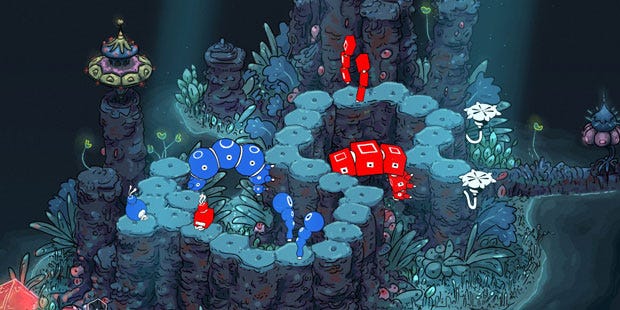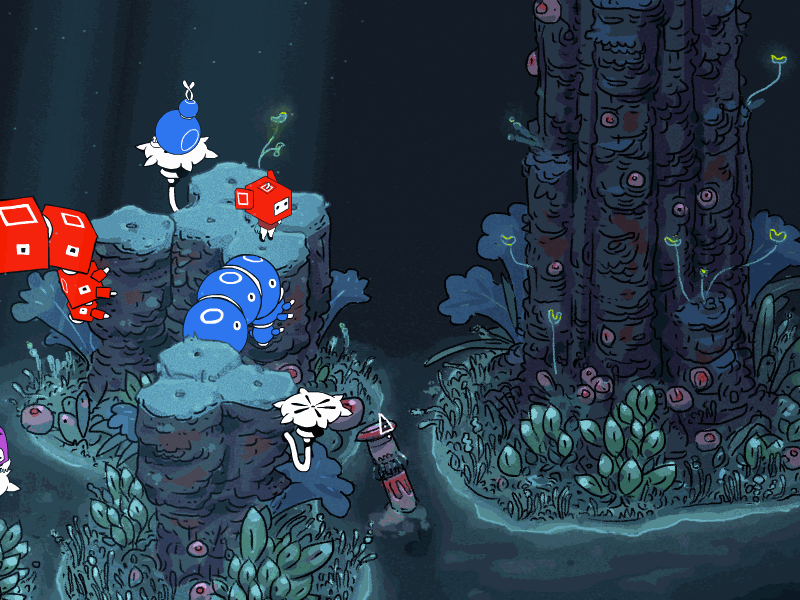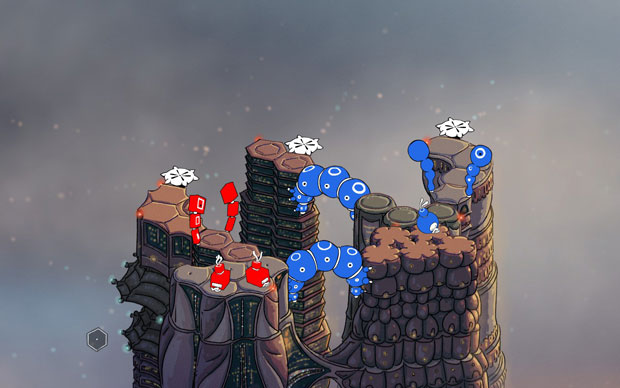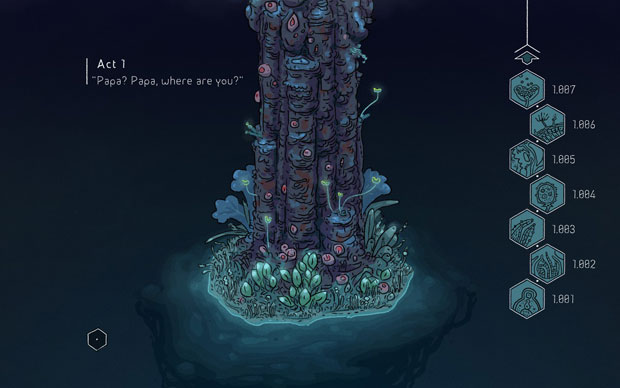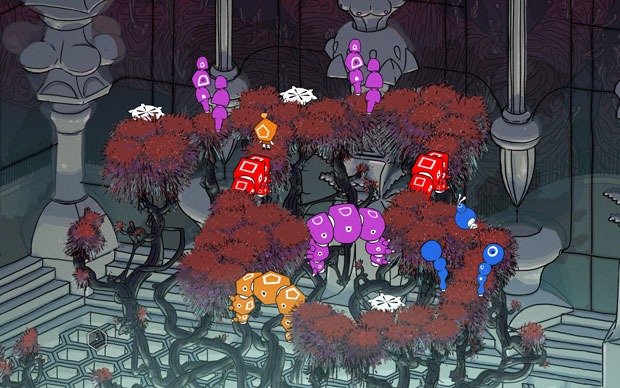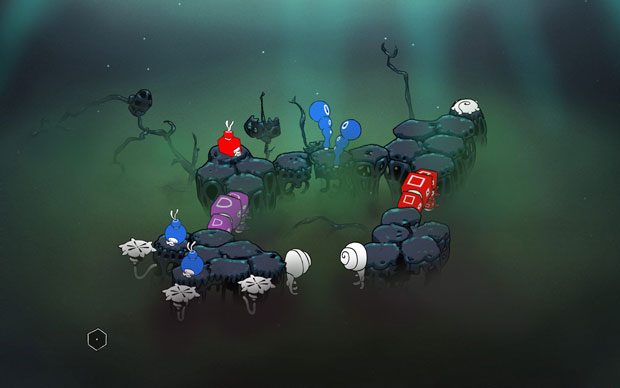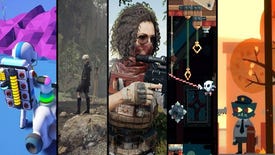Wot I Think: She Remembered Caterpillars
Logic and loss infuse this beautiful puzzler
I finished She Remembered Caterpillars [official site] last night and have been mulling it over since then. It's the sort of game which needs a bit of time to settle. You've got the logic puzzle side of things set in a gorgeous little world of colourful bridges and gates which the developers describe as "fungipunk" and you've got the narrative which is drip fed as snippets between puzzles. Having mulled, here's Wot I Think:
First I'll explain what you actually do in She Remembered Caterpillars:
Each level is an island composed of platforms and pathways. There are little coloured sprites you can move around the levels and the aim is to get one onto each of the white pads dotted around the playspace. The puzzle comes because pathways can be gated by coloured gates and bridges. The game introduces the concepts to you gradually, one element at a time, and you learn them by moving around the space but the key points are as follows:
Coloured bridges let any sprite that contains that colour cross. For example, a red bridge can be crossed by a red sprite but ALSO by an orange or a purple sprite because those sprites contain red alongside another colour.
Coloured gates prohibit sprites which contain those colours. For example, a red gate prohibits red sprites and orange sprites and purple sprites.
(N.B. There are provisions for colourblind players in that each colour is attached to a specific shape and those shapes are features on the sprites, gates and bridges so you'd still get the information you need to solve puzzles. Secondary colours like green are expressed as a combination of the shapes for yellow and blue, so a circle and a triangle merge to become a teardrop.)
The fact that these puzzles are very much exercises in logic is tempered by the art style which is very friendly, adorable and organic. The animations for when you mix sprites together, or when a bridge or gate won't let you cross are also playful and combine with pleasingly atmospheric sound effects. I feel like if logic puzzles aren't traditionally your thing you might still want to try the demo because the way it introduces the concepts and lets you learn by trial and error feels accessible.
Logic puzzles definitely ARE my thing – it's why I'm the person who ended up playing this in the first place and why I gravitated towards it on previous Expo show floors back when it was called Perlinoid. For me it was a real pleasure in terms of the puzzling as well as inhabiting the little world.
It's a weird thing trying to explain to someone else the feeling of solving a puzzle in a game. I've been trying to pin down what happens in some form while working through the colour/shape puzzles of She Remembered Caterpillars in the hopes that it will be helpful. I want to communicate why I like this sort of thing and what it feels like when it does hit the beats of bafflement, testing, assessing and solution in just the right way.
I think the best way I've found is to think of each puzzle as a potential moment of recognition, like a snatch of music or a celebrity face or a quote from a book. A good spatial logic puzzle shows you all the elements – it plays you the song or give you a photo of a face or reads you quotation and then you spend time replaying it over and over as if you can't quite remember the name of the song or the celebrity or the author. You turn it this way and that, and maybe get flashes of the initial letters or how many syllables it has or a related TV show or something, then you have that moment of pinning it down and recognising the solution.
With this game I would say it's not fiendishly difficult because the playspaces are relatively small so there are only a certain number of possible moves you can make. I feel like it might be possible to make a fair dent in the game just by pottering and tinkering and not entirely knowing how you reached the end of a puzzle. (However I do know that it frustrated and confounded John because it is very much not his thing so maybe I have a skewed sense of difficulty because this way of thinking comes more easily to me.)
I had that pottering and uncertainty happen a couple of times, so there are levels I don't technically know how to complete even though I completed them. It's a feeling that gets exacerbated by the lack of a "back" button if you want to undo moves and can't reverse what you've just done. Having to do a hard reset sometimes felt like losing a lot of progress if you weren't sure how you'd surmounted a particular obstacle.
More often it was about seeing the final moves I'd need to make and working back from there, refining the list of possible moves and possible final pads for each sprite until it became a series of movements. Some were harder than others, although I think at times I hit a mental brick wall because I slipped out of the puzzle mindspace rather than the game getting significantly more difficult. Do you know the feeling? Like, you're merrily making headway through a game and everything's snapping into place but you get a Skype call or make lunch and suddenly that flow has evaporated. You can't force it back either, which is a pain when there's a review to be written!
Accompanying the game is a narrative of sorts. I say "of sorts" because it unfurls through little vignettes and snippets of chat which preface each level. So it's more like a scrapbook of a story than the whole story and it encourages you to fill in the gaps. At first I really didn't warm to it because it felt too divorced from the puzzling, although the choice of vocabulary did provide a kind of narrative umbilical cord. By that I mean the words and some of the imagery referenced the same kind of warm, organic mulch that you get from the art style. They shared a language, but the connection between the actual bones of the story and the puzzles felt absent – I chafed against it because it felt like a kind of self-consciously artsy icing on a fundamentally logical cake.
Metaphors are a casualty of my current wicked bout of insomnia, by the way.
But that insomnia is also something which gave me an "aha" moment with the story. It's frustrating because I honestly can't talk about the specifics of that aha moment without real spoilers, PLUS it might be entirely personal and not what the team actually intended, but it reoriented the narrative and connected it with the puzzles in a way which felt meaningful. The two still don't quite gel for me – there's still an unease or a distance when I go from puzzle to text or vice versa, and the storytelling became a bit heavy-handed or overworked towards the end – but generally there was a sense of having reconciled the two.
I'd also point out that, when trying to remember the previous name for the game, I ended up reading a bit on the dev website about the name change:
"We struggled with Perlinoid for quite a while now. It is a very unique name which is good in terms of search engine results but getting people to remember the name? That was a whole different thing. The new name is based on the story of the game. And from what we can tell, it seems to work a lot better already."
I've been thinking about this and one of the thoughts which bubbled up was that the narrative seems to have helped the developers feel out something important about their game. There's definitely a coherence and a beauty here that I don't recall from playing Perlinoid. The other thing is that, as per the press kit, the story was initially something different, something rooted in stories from Egyptian mythology.
"Cassandra Khaw joined the team as a writer. Her initial approach was retelling the Isis and Osiris myth through a post-apocalyptic fungipunk tale. A myth about life, and death, and then life again. However, a few months later her father died and the story was rewritten. Instead she wanted to talk about grief and about bereavement and losing your parents: deaths are inevitable in everyone’s lives."
Obviously that isn't something people need to know going into the game, but it was interesting to think about the value of the story not necessarily being for the players but for the writer. It might not make it any more enjoyable for you – I know John bounced off it hard – but it's one of the thoughts I wanted to write down as I tried to figure out why this thing would chafe and then gel and then chafe and then gel and then feel heavy-handed and then sweet. It was all small – there was no love/hate rollercoaster – it just never quite settled.
It is lovely, though, and one of the friendliest, warmest logic puzzlers I've played.
If you're interested there's a demo over on itch.io and the game itself is available via Humble (for a Steam key) and directly via Steam. There's a slight price difference - the Humble version is about 80p ($1) more expensive for the same thing - in case that affects your decision on that front.
[Disclosure: Cass Khaw has been involved in She Remembered Caterpillars and is credited as being responsible for the game's narrative. She used to work for us, picking up the Bargain Bucket column and doing news shifts before going on to join the "writing for" rather than "writing about" side of games.]
